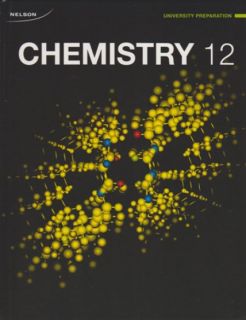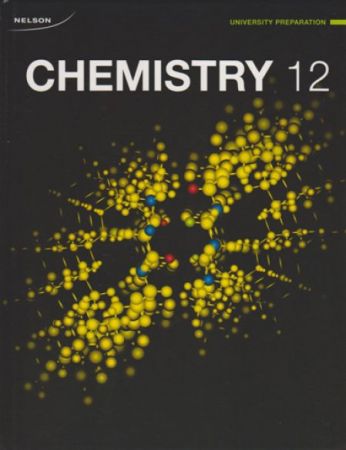Suppliers
Other Departments
Shop by Brand
More Information
.png)

Suppliers > Nelson Education Ltd.
Nelson Chemistry 12 University Preparation
Model: 9780176520618
The Nelson Chemistry 12 University Preparation - Student Textbook supports the Ontario Ministry of Education
Course: Chemistry, Grade 12, University Prepration, Course Code: SCH4U
Author Team: Maurie DiGiuseppe, Stephen Haberer, Kristina Salciccioli, Milan Sanader, Angela Vavitsas
It has these units and chapters:
Unit 1: Organic Chemistry
Chapter 1: Organic Compounds
1.1 Alkans
1.2 Alkans and Alkynes
1.3 Aromatic Hydrocarbons
1.4 Alcohols, Ethers, and Thoils
1.5 Aldehydes and Ketones
1.6 Carboxylic Acids, Esters, and Fats
1.7 Amines and Amides
Investigation 1.4.1: Properties of Alcohols
Investigation 1.5.1: Reactions of Three Isomers of Butanol
Investigation 1.6.1: Properties of Carboxylic Acids
Investigation 1.6.2: Synthesizing Esters
Investigation 1.6.3: Making Soap (Teacher Demonstration)
Investigation 1.7.1: Building Organic Molecular Models
Chapter 2: Polymers
2.1 Introudcing Polymers
2.2 Synthetic Addition Polymers
2.3 Explore an Issue in Polymer Techonology: Plasticizers and Human Health
2.4 Synthetic Condensation Polymers
2.5 Chemistry Journal: The Invention of Nylon
2.6 Natural Polymers
Investigation 2.4.1: Preparation of a Polyester
Unit 2: Structure and Properties of Matter
Chapter 3: Atoms
3.1 Early Atomic Theories and the Origins of Quantum Theory
3.2 Bohr's Model of the Atom
3.3 The Quantum Mechanical Model of the Atom
3.4 Quantum Numbers
3.5 Atomic Structure and the Periodic Table
3.6 Applications of Quantum Mechanics
3.7 Explore an Application in Quantum Mechanics: The Tiny World of Nanotechnology
Investigation: 3.1.1: The Photoelectric Effect
Investigation: 3.2.1: Bright-Line Spectra
Investigation: 3.4.1: Simulation of Electron Orbitals
Investigation: 3.5.1: Paramagnetism
Chapter 4: Chemical Bonding
4.1 Types of Chemical Bonds
4.2 Three-Dimensional Structure
4.3 Electronegativity and Bond Polarity
4.4 Chemistry Journal: Gillespie and the VSEPR Model
4.5 Molecular Polarity
4.6 Quantum Mechanics and Bonding: Hybridization
4.7 Intermolecular Forces
4.8 The Structure and Properties of Solids
Investigation 4.2.1: Three-Dimensional Shape
Investigation 4.5.1: Testing for Polar Molecules
Investigation 4.7.1: Hydrogen Bonding
Investigation 4.7.2: Boiling Points and Intermolecular Forces
Investigation 4.8.1: Identifying Solids
Unit 3: Energy Changes and Rates of Reaction
Chapter 5: Thermochemistry
5.1 Energy Changes in Chemical and Nuclear Reactions
5.2 Calorimetry and Enthalpy
5.3 Bond Energies
5.4 Hess's Law
5.5 Standard Enthalpies of Formation
5.6 Present and Future Energy Sources
5.7 Explore an Issue in Wind Technology: Is Wind Technology the Answer?
Investigation 5.2.1: Molar Enthalpy of a Chemical Change
Investigation 5.4.1: Hess's Law
Investigation 5.5.1: Calorimetry versus Enthalpies of Formation
Chapter 6: Chemical Kinetics
6.1 Reaction Rates
6.2 Factors Affecting Reaction Rates
6.3 Explaining Reaction Rates
6.4 Explore an Application of Chemical Kinetics: Biocatalysts and the Environment
6.5 Rate Law
6.6 Reacion Mechanisms
6.7 Chemistry Journal: Global Warming and Reaction Rates
Investigation 6.1.1: Reaction Rates
Investigation 6.2.1: Factors Affecting the Rate of Chemical Reactions
Investigation 6.5.1: The Iodine Clock Reaction System
Unit 4: Chemical Systems and Equilibrium
Chapter 7: Chemical Equilibrium
7.1 Equilibrium Systems
7.2 Equilibrium Law and the Equilibrium Constant
7.3 Chemistry Journal: Fritz Haber: Explore an Equilibrium, Feed the World
7.4 Qualitative Changes in Equilibrium Systems
7.5 Quantitative Changes in Equilibrium Systems
7.6 solubility Equilibria and the Solubility Product Constant
Investigation 7.1.1: The Extent of a Chemical Reaction
Investigation 7.2.1: The Equilibrium Law
Investigation 7.4.1: Testing Le Châtelier's Principle
Investigation 7.6.1: The Ksp of Calcium Hydroxide
Chapter 8: Acid-Base Equilibrium
8.1 The Nature of Acids and Bases
8.2 Strong and Weak Acids and Bases
8.3 Explore Applications of Acids: Equilibrium in an Industrial Process
8.4 Calculation Involving Acidic Solutions
8.5 Calculation Involving Basic Solutions
8.6 Acid-Base Properties of Salt Solutions
8.7 Acid-Base Titration
8.8 Buffer Systems
8.9 Explore an Issue in Acids and Bases: Additivies in the Food and Beverage Industry
Investigation 8.6.1: The Acidity of Salt Solutions
Investigation 8.7.1: Acid-Base Titration
Investigation 8.8.1: Buffer Systems
Investigation 8.8.2: The Effectiveness of an Antacid
Unit 5: Electrochemistry
Chapter 9: Oxidatin-Reduction Reactions
9.1 Electron Transfer Reactions
9.2 Balancing Redox Reaction Equations
9.3 Predicting Redox Reactions
Investigation 9.1.1: single Displacement
Investigation 9.3.1: Spontaneity of Redox Reactions
Chapter 10: Electrochemical Cells
10.1 Galvanic Cells
10.2 Standard Reduction Potentials
10.3 Cells and Batteries
10.4 Explore an Issue in Electrochemistry: Pick Your Energy Source: Lithium or Hydrogen?
10.5 Chemistry Journal: Cold Fusion: The Discovery That Never Happened
10.6 Corrosion
10.7 Electrolysis
Investigation 10.1.1: Investigating Galvanic Cells
Investigation 10.2.1: Constructing a Galvanic Cell
Investigation 10.2.2: Investigatiing a Cell Potentials
Investigation 10.6.1: Testing the Corrosion of Iron
For each chapter, there are Summary, Self-Quiz and Review.
For each unit, there are Task, Self-Quiz and Review.
Numerical and short answers are given at the end of the textbook.
Hardcover, 770 pages, book size: 22 cm x 28 cm x 3 cm




